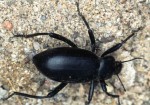
Click On Picture for Larger Image
Darkling Beetles
Author: Ray Bowers
 Click On Picture for Larger Image |
Species: Eleodes obscurus |
Description:
Darkling beetles are about 18mm to 30mm ( 0.75 to 1,5in ) long and an elongate oval in shape, that is black in color. The head contains notched eyes, thread-like antennae, and chewing mouth parts. The front wings are smooth and shiny, and the legs are long.
Geographic range:
There are 100 species in the Western United States, and these Beetles are one of the most commonly seen insects in the Jornada Basin.
Habitat:
The darkling beetle is found in a variety of desert habitats such as shrub lands, grasslands, and arroyos.
Food Web:
Darkling beetles feed on plant material as adults and larva. The adults feed on leaves and seeds on the surface. The larva, called wireworms, look like mealworms and feed on plant material below the soil surface.
Reproduction and Development:
Darkling beetles undergo complete metamorphosis. The eggs are laid in a favorable location, when the eggs hatch the larva burrow below the soil. As the larva grows it reaches a point in its life cycle when it goes into a resting stage or pupa where it changes into the adult form.
Behavior:
Adult beetles are diurnal and nocturnal, although they may seek shade during the hottest part of the day. When the adults are disturbed they raise their abdomen and lower their heads, and may walk away in this position. If further disturbed they can spray a liquid with an offensive odor from their abdomen.
Ecosystem roles:
Darkling beetles feed on plant material, and in turn may be eaten by larger predators.
Other info:
Darkling beetles can be kept as pets if fed dry oatmeal and small pieces of apple or potato.
Taxonomy:
Kingdom: Animalia
Phylum:Arthropoda
Subphylum:Atelocerata
Class:Hexapoda
Order:Coleoptera
Family:Tenebrionidae
Genus:Eleodes
Species:Eleodes obscurus
References:
Borror, Donald J. and Richard E. White. 1970. A Field Guide to the Insects of America North of Mexico. Boston : Houghton Mifflin Co.
Borror, Donald J., Charles A. Triplehorn, and Norman F. Johnson. 1989. An Introduction to the Study of Insects. Philadelphia: W. B. Saunders Co.
Bland, Roger G and H. E. Jaques.1978. How to Know Insects. Dubuque , Iowa : Wm. C. Brown Co.
Larson, Peggy and Lane Larson. 1977. The Deserts of the Southwest. San Francisco : Sierra Club Books.
MacMahon. James A.1985. Deserts. New York : Alfred A Knopf, Inc.
Werner, Floyd and Carl Olson. 1994. Insects of the Southwest. Fisher Books, LLC.
White, Richard E.. 1983. A Field Guide to the Beetles of North America . Boston : Houghton Mifflin Co.
Related Terms: Hexapoda, Insects